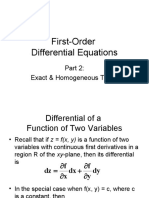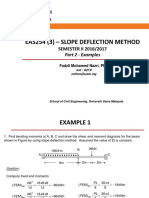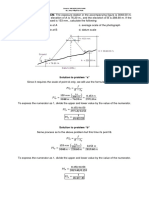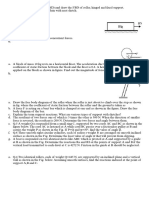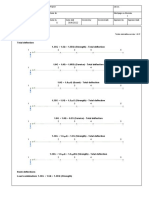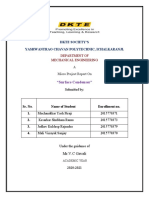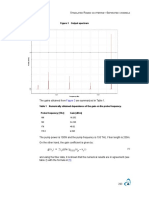0 ratings0% found this document useful (0 votes)
149 viewsMathalino PSET
Mathalino PSET
Uploaded by
sbelodoThis document contains 40 mechanics problems involving concepts like forces, motion, friction, centroids, moments of inertia, and projectile motion. The problems involve computing values like forces, accelerations, times, distances, and coordinates using given equations and diagrams showing physical systems like blocks on inclined planes, pulleys with hanging masses, beams, and projectile trajectories.
Copyright:
© All Rights Reserved
Available Formats
Download as DOCX, PDF, TXT or read online from Scribd
Mathalino PSET
Mathalino PSET
Uploaded by
sbelodo0 ratings0% found this document useful (0 votes)
149 views5 pagesThis document contains 40 mechanics problems involving concepts like forces, motion, friction, centroids, moments of inertia, and projectile motion. The problems involve computing values like forces, accelerations, times, distances, and coordinates using given equations and diagrams showing physical systems like blocks on inclined planes, pulleys with hanging masses, beams, and projectile trajectories.
Copyright
© © All Rights Reserved
Available Formats
DOCX, PDF, TXT or read online from Scribd
Share this document
Did you find this document useful?
Is this content inappropriate?
This document contains 40 mechanics problems involving concepts like forces, motion, friction, centroids, moments of inertia, and projectile motion. The problems involve computing values like forces, accelerations, times, distances, and coordinates using given equations and diagrams showing physical systems like blocks on inclined planes, pulleys with hanging masses, beams, and projectile trajectories.
Copyright:
© All Rights Reserved
Available Formats
Download as DOCX, PDF, TXT or read online from Scribd
Download as docx, pdf, or txt
0 ratings0% found this document useful (0 votes)
149 views5 pagesMathalino PSET
Mathalino PSET
Uploaded by
sbelodoThis document contains 40 mechanics problems involving concepts like forces, motion, friction, centroids, moments of inertia, and projectile motion. The problems involve computing values like forces, accelerations, times, distances, and coordinates using given equations and diagrams showing physical systems like blocks on inclined planes, pulleys with hanging masses, beams, and projectile trajectories.
Copyright:
© All Rights Reserved
Available Formats
Download as DOCX, PDF, TXT or read online from Scribd
Download as docx, pdf, or txt
You are on page 1of 5
MECHANICS the rod and the incline.
1. The 2225-N block shown in Fig. P-507 is in contact
with 45° incline. The coefficient of static friction is 0.25.
Compute the value of the horizontal force P necessary to
(a) just start the block up the incline or (b) just prevent
motion down the incline. (c) If P = 1780 N, what is the
amount and direction of the friction force?
5. A 300-lb box is held at rest on a smooth plane by a
force P inclined at an angle θ with the plane as shown in
Fig. P-310. If θ = 45°, determine the value of P and the
normal pressure N exerted by the plane.
2. The 200-lb block shown in Fig. P-508 has impending
motion up the plane caused by the horizontal force of
400 lb. Determine the coefficient of static friction
between the contact surfaces.
6. If the value of P in Fig. P-310 is 180 lb, determine the
angle θ at which it must be inclined with the smooth
plane to hold 300-lb box in equilibrium.
3. The cable and boom shown in Fig. P-308 support a
load of 600 lb. Determine the tensile force T in the cable 7. Determine the magnitude of P and F necessary to
keep the concurrent force system in Fig. P-312 in
and the compressive for C in the boom.
equilibrium.
8. Figure P-313 represents the concurrent force system
4. A cylinder weighing 400 lb is held against a smooth acting at a joint of a bridge truss. Determine the value of
incline by means of the weightless rod AB in Fig. P-309. P and E to maintain equilibrium of the forces.
Determine the forces P and N exerted on the cylinder by
9. The five forces shown in Fig. P-314 are in
equilibrium. Compute the values of P and F.
13. Three bars, hinged at A and D and pinned
at B and C as shown in Fig. P-318, form a four-link
mechanism. Determine the value of P that will prevent
motion.
10. The 300-lb force and the 400-lb force shown in Fig.
P-315 are to be held in equilibrium by a third force F
acting at an unknown angle θ with the horizontal.
Determine the values of F and θ.
14. Cords are loop around a small spacer separating two
cylinders each weighing 400 lb and pass, as shown in
Fig. P-319 over a frictionless pulleys to weights of 200
lb and 400 lb .
11. Determine the values of α and θ so that the forces
shown in Fig. P-316 will be in equilibrium.
Determine the angle θ and the normal pressure N
between the cylinders and the smooth horizontal surface.
15. A wheel of 10-in radius carries a load of 1000 lb, as
12. The system of knotted cords shown in Fig. P-317 shown in Fig. P-324.
support the indicated weights. Compute the tensile force
in each cord.
(a) Determine the horizontal force P applied at the center
which is necessary to start the wheel over a 5-in. block.
Also find the reaction at the block.
16. Determine the amount and direction of the smallest
force P required to start the wheel in Fig. P-325 over the
block. What is the reaction at the block?
19. Two weightless bars pinned together as shown in
Fig. P-328 support a load of 35 kN.
17. The cylinders in Fig. P-326 have the indicated
weights and dimensions. Assuming smooth contact
surfaces, determine the reactions at A, B, C, and D on
the cylinders.
Determine the forces P and F acting respectively along
bars AB and AC that maintain equilibrium of pin A.
20. The dimensions of the T-section of a cast-iron beam
18. Forces P and F acting along the bars shown in Fig. are shown in Fig. P-714. How far is the centroid of the
P-327 maintain equilibrium of pin A. Determine the area above the base?
values of P and F.
24. Determine the x-coordinate.
21. Determine the coordinates of the centroid of the area
shown in Fig. P-715 with respect to the given axes.
25. Determine the moment of inertia and radius of
gyration with respect to a polar centroidal axis of the
cross section of a hollow tube whose outside diameter is
6 in. and inside diameter is 4 in.
22. The centroid of the sahded area in Fig. P-720 is
required to lie on the y-axis. Determine the distance b
that will fulfill this requirement.
26. Determine the moment of inertia of the area
shown in Fig. P-819 with respect to its centroidal
axes.
23. Find the coordinates of the centroid of the shaded
area shown in Fig. P-724.
27. Find the moment of inertia about the indicated 35. A stone is thrown vertically up from the ground
with a velocity of 300 ft per sec (91.44 m/s). How
x-axis for the shaded area shown in Fig. P-821.
long must one wait before dropping a second stone
from the top of a 600-ft (182.88-m) tower if the
two stones are to pass each other 200 ft (60.96 m)
from the top of the tower?
36. A ship being launched slides down the ways
with constant acceleration. She takes 8 sec to slide
(the first foot | 0.3048 meter). How long will she
take to slide down the ways if their length is (625 ft
| 190.5 m)?
37. A train moving with constant acceleration
travels 24 ft (7.32 m) during the 10th sec of its
motion and 18 ft (5.49 m) during the 12th sec of its
motion. Find its initial velocity and its constant
acceleration.
28. On a certain stretch of track, trains run at 60
mph (96.56 kph). How far back of a stopped train 38. The motion of a particle is given by the equation
should be a warning torpedo be placed to signal an s=2t4−16t3+2t2 where s is in meter and t in seconds.
oncoming train? Assume that the brakes are Compute the values of v and a when t=2 sec.
applied at once and retard the train at the uniform
rate of 2 ft/sec2 (0.61 m/s2). 39. A projectile is fired up the inclined plane at an
initial velocity of 15 m/s. The plane is making an
29. A stone is thrown vertically upward and return angle of 30° from the horizontal. If the projectile
to earth in 10 sec. What was its initial velocity and was fired at 30° from the incline, compute the
how high did it go? maximum height z measured perpendicular to the
incline that is reached by the projectile. Neglect air
30. A ball is dropped from the top of a tower 80 ft resistance.
(24.38 m) high at the same instant that a second
ball is thrown upward from the ground with an 40. A bullet is fired at an initial velocity of 150 m/s
initial velocity of 40 ft/sec (12.19 m/s). When and and an angle of 56° at the top of a 120 m tall
where do they pass, and with what relative velocity? building. Neglecting air resistance, determine the
following:
31. A stone is dropped down a well and 5 sec later, A. The maximum height above the level ground
the sounds of the splash is heard. If the velocity of that can be reached by the bullet.
sound is 1120 ft/sec (341.376 m/s), what is the B. The time for the bullet to hit the ground.
depth of the well? C. The velocity with which the bullet will hit the
ground.
32. A stone is dropped from a captive balloon at an
elevation of 1000 ft (304.8 m). Two seconds later 41. Determine the magnitude of the resultant, its
another stone is thrown vertically upward from the pointing, and its direction cosines for the following
ground with a velocity of 248 ft/s (75.6 m/s). If g = system of non-coplanar concurrent forces. 100 lb
32 ft/s2 (9.75 m/s2), when and where the stones (2, 3, 4); 300 lb (–3, –4, 5); 200 lb, (0, 0, 4).
pass each other?
42. Determine the magnitude of the resultant, its
33. A stone is thrown vertically upward from the pointing, and its direction cosines for the following
ground with a velocity of 48.3 ft per sec (14.72 m system of non-coplanar concurrent forces. 200 lb
per sec). One second later another stone is thrown (4, 5, –3); 400 lb (–6, 4, –5); 300 lb, (4, –2, –3).
vertically upward with a velocity of 96.6 ft per sec
(29.44 m per sec). How far above the ground will
the stones be at the same level?
34. A ball is shot vertically into the air at a velocity
of 193.2 ft per sec (58.9 m per sec). After 4 sec,
another ball is shot vertically into the air. What
initial velocity must the second ball have in order to
meet the first ball 386.4 ft (117.8 m) from the
ground?
You might also like
- 04 First-Order DE Part 2 v3 (AY 2014-2015, With Answers)Document41 pages04 First-Order DE Part 2 v3 (AY 2014-2015, With Answers)Patrice Pauline TamoriaNo ratings yet
- Zick AnalysisDocument12 pagesZick AnalysisrksahayNo ratings yet
- Resultant of Parallel ForcesDocument14 pagesResultant of Parallel ForcesJEH222No ratings yet
- Engineering Mechanics and Strength of MaterialsDocument9 pagesEngineering Mechanics and Strength of MaterialsscarlettNo ratings yet
- Mof-Chapter-2 - 20 PDFDocument45 pagesMof-Chapter-2 - 20 PDFMOHAMMED NOUMAN A Dept of Civil EngineeringNo ratings yet
- c04 PDFDocument62 pagesc04 PDFLuis RossoNo ratings yet
- Statics FramesDocument14 pagesStatics Framesara delgadoNo ratings yet
- 1 - Equilibrium of A ParticleDocument25 pages1 - Equilibrium of A Particlealnd azadNo ratings yet
- Bs Civil Engineering Cagayan State University - CarigDocument40 pagesBs Civil Engineering Cagayan State University - CarigSamantha CusiNo ratings yet
- Moments MechanicsDocument173 pagesMoments MechanicsChicha WatersNo ratings yet
- Engg MechanicsDocument31 pagesEngg MechanicsMuzahid IslamNo ratings yet
- Arches: Theory of StructuresDocument20 pagesArches: Theory of StructuresAravind BhashyamNo ratings yet
- Volume CentroidDocument6 pagesVolume CentroidZsaneen Mariz Tulabut100% (1)
- The Water Sprinkler A Is Placed On Sloping Ground and Oscillates in The XyDocument14 pagesThe Water Sprinkler A Is Placed On Sloping Ground and Oscillates in The XyChristine Joyce BunyiNo ratings yet
- Day 8 Plane Geometry December 01 20212Document51 pagesDay 8 Plane Geometry December 01 20212Free student100% (1)
- Ch2 SMDocument17 pagesCh2 SMKarla RodriguezNo ratings yet
- Module-3 Parallel ForcesDocument3 pagesModule-3 Parallel ForcesashwinikunayakNo ratings yet
- MAT 076 - Integral CalculusDocument175 pagesMAT 076 - Integral Calculusangpa.acosta.auNo ratings yet
- Lesson 9 Method of Members Frames Composite StructuresDocument3 pagesLesson 9 Method of Members Frames Composite StructuresKristine PanlilioNo ratings yet
- Lecture 2 Curvilinear MotionDocument87 pagesLecture 2 Curvilinear MotionDave CruzNo ratings yet
- Engineering Mechanics: Statics of Rigid BodiesDocument62 pagesEngineering Mechanics: Statics of Rigid BodiesairaNo ratings yet
- Determine The Force Developed in Members GB G F of The Bridge Truss State If These Membel-S Are Tension or CompressionDocument23 pagesDetermine The Force Developed in Members GB G F of The Bridge Truss State If These Membel-S Are Tension or CompressionNarang ViNo ratings yet
- Normal and Shear Stress PDFDocument25 pagesNormal and Shear Stress PDFmohanadymtNo ratings yet
- Couple: Engr. Angelica A. LosaresDocument12 pagesCouple: Engr. Angelica A. LosaresArkie TectureNo ratings yet
- T Tests Independent and PairedDocument25 pagesT Tests Independent and PairedJhon Michael SabioNo ratings yet
- Bearing and AzimuthDocument13 pagesBearing and AzimuthSupot TuliNo ratings yet
- DYNAMICS: Work and EnergyDocument4 pagesDYNAMICS: Work and EnergyJae Anne SarabiaNo ratings yet
- Lecture 2Document47 pagesLecture 2Ivy AlNo ratings yet
- Lecture 11 - Introduction To Distributed Normal LoadsDocument30 pagesLecture 11 - Introduction To Distributed Normal LoadsLantretz LaoNo ratings yet
- ENS 161 - Lecture 5Document29 pagesENS 161 - Lecture 5NAJEB PENDIAMANNo ratings yet
- Solutions Chapter 2 (WǪ) PDFDocument16 pagesSolutions Chapter 2 (WǪ) PDF黃羿傑No ratings yet
- EDA Lec10 Solutions To Selected ProblemsDocument5 pagesEDA Lec10 Solutions To Selected ProblemsEri EliNo ratings yet
- Solution: PROBLEM 13.12Document2 pagesSolution: PROBLEM 13.12Nattamon PetchkeawNo ratings yet
- Moment Diagram by PartsDocument14 pagesMoment Diagram by PartsJay Dela CruzNo ratings yet
- Quiz 1 1Document2 pagesQuiz 1 1Kapukets GreyNo ratings yet
- Chapter 2 - Part 1 PDFDocument41 pagesChapter 2 - Part 1 PDFEngr XsadNo ratings yet
- Eas254 - SDM Part 2 - ExamplesDocument15 pagesEas254 - SDM Part 2 - ExamplesNasrulNo ratings yet
- Chapter 1Document12 pagesChapter 1Lester Neil LomodNo ratings yet
- Mathalino: Yes, Numerade Has The AnswersDocument5 pagesMathalino: Yes, Numerade Has The AnswersShiela GonzalesNo ratings yet
- Chapter IV Shear and Moment in Beams 4.4Document6 pagesChapter IV Shear and Moment in Beams 4.4Joshua John JulioNo ratings yet
- Rigid CalculationDocument66 pagesRigid CalculationMotasem BMNo ratings yet
- ES 23 Chapters PDFDocument92 pagesES 23 Chapters PDFJohn Reigh CatipayNo ratings yet
- Chapter 12Document8 pagesChapter 12이희인No ratings yet
- Sample ProblemDocument4 pagesSample ProblemRenalyn D. BantotoNo ratings yet
- 02 Chapter 2 - Force VectorDocument20 pages02 Chapter 2 - Force VectorShaun KerouacNo ratings yet
- Solution of Statics - Assignment 8Document8 pagesSolution of Statics - Assignment 8Omar NabilNo ratings yet
- Problem 2, 3, 4Document7 pagesProblem 2, 3, 4Stan LeyNo ratings yet
- Strain (Continuation) PDFDocument3 pagesStrain (Continuation) PDFNadlor Gasco OzausNo ratings yet
- Set 7 Fluid Properties and Hydrostatic ForceDocument12 pagesSet 7 Fluid Properties and Hydrostatic ForceChristine TabangNo ratings yet
- 4 PrintDocument8 pages4 PrintsubyNo ratings yet
- Strema FormulaDocument6 pagesStrema FormulaEj ParañalNo ratings yet
- Torsion Sample Problem 2Document9 pagesTorsion Sample Problem 2Richiel Pasilan LañohanNo ratings yet
- Chapter 6-Dynamics-Kinematics-KineticsDocument36 pagesChapter 6-Dynamics-Kinematics-KineticsO.SNo ratings yet
- BldgElectSystems - AddlexamplesDocument11 pagesBldgElectSystems - AddlexamplesChristian AldeNo ratings yet
- DongDocument2 pagesDongcessNo ratings yet
- Probable Question - Docx - 20241121 - 193415 - 0000Document8 pagesProbable Question - Docx - 20241121 - 193415 - 0000purushottamapandaNo ratings yet
- E Mech 22-23Document17 pagesE Mech 22-23Subrata MondalNo ratings yet
- Class Problems Sentences 13 The DDocument20 pagesClass Problems Sentences 13 The DKnowledgeIsTruePowerNo ratings yet
- Find The X and y Components of Each Force and Determine The Resultant and Direction PGNO31Document5 pagesFind The X and y Components of Each Force and Determine The Resultant and Direction PGNO31sivakumarNo ratings yet
- Practice Set 4 - SolnDocument14 pagesPractice Set 4 - Solngewemac960No ratings yet
- GMP, Ssop, HaccpDocument74 pagesGMP, Ssop, HaccpsbelodoNo ratings yet
- 2023 - Analytical Chemistry With Answers 1Document14 pages2023 - Analytical Chemistry With Answers 1sbelodoNo ratings yet
- Carpool RulesDocument3 pagesCarpool RulessbelodoNo ratings yet
- ExamDocument8 pagesExamsbelodoNo ratings yet
- PDF 20230108 215124 0000Document2 pagesPDF 20230108 215124 0000sbelodoNo ratings yet
- PhyChem Lab2 FinalDocument8 pagesPhyChem Lab2 FinalsbelodoNo ratings yet
- GLOBAL VILLAGE STORIES - A Relational Art Project: DescriptionDocument30 pagesGLOBAL VILLAGE STORIES - A Relational Art Project: DescriptionsbelodoNo ratings yet
- Buffer-Titration-Equilibrium Practice ProblemsDocument18 pagesBuffer-Titration-Equilibrium Practice ProblemssbelodoNo ratings yet
- Saftey Prelim ANSDocument5 pagesSaftey Prelim ANSsbelodo100% (1)
- UTS ExamDocument4 pagesUTS ExamsbelodoNo ratings yet
- Mathalino - SomDocument1 pageMathalino - SomsbelodoNo ratings yet
- Mathalino - Related RatesDocument1 pageMathalino - Related RatessbelodoNo ratings yet
- Solid Mensuration: PinoybixDocument10 pagesSolid Mensuration: PinoybixsbelodoNo ratings yet
- Pset Oct 2022Document1 pagePset Oct 2022sbelodoNo ratings yet
- GLOBAL VILLAGE STORIES - A Relational Art Project: DescriptionDocument30 pagesGLOBAL VILLAGE STORIES - A Relational Art Project: DescriptionsbelodoNo ratings yet
- 4.LivingRoom - Beam2.Analysis (Eurocodes)Document6 pages4.LivingRoom - Beam2.Analysis (Eurocodes)zms msswiNo ratings yet
- Swell Pressure Test: 1. ObjectiveDocument4 pagesSwell Pressure Test: 1. Objectiveraviteja036No ratings yet
- Analisis SPM & Perincian (Fizik)Document5 pagesAnalisis SPM & Perincian (Fizik)simoncktNo ratings yet
- International Standards in Nanotechnologies: A B C C DDocument15 pagesInternational Standards in Nanotechnologies: A B C C DDanilo FerreiraNo ratings yet
- E-CAPS-28 - For CoE (XI) - Chemistry - (Que. - Answer Key)Document3 pagesE-CAPS-28 - For CoE (XI) - Chemistry - (Que. - Answer Key)darling deanNo ratings yet
- SmawDocument78 pagesSmawBrijraj PandeyNo ratings yet
- EDF2: A Density Functional For Predicting Molecular Vibrational FrequenciesDocument6 pagesEDF2: A Density Functional For Predicting Molecular Vibrational FrequenciesALDO JAVIER GUZMAN DUXTANNo ratings yet
- DS-1 4th Ed - Volume 3 - Addendum 2Document7 pagesDS-1 4th Ed - Volume 3 - Addendum 2MARVELNo ratings yet
- Sci9 Q2 Module 2 Chemical BondingDocument36 pagesSci9 Q2 Module 2 Chemical BondingCleeve Wyn EgotNo ratings yet
- Optimizing RF Properties of Injection Molded Plastic PartsDocument26 pagesOptimizing RF Properties of Injection Molded Plastic PartsclanonNo ratings yet
- Applied Physics B.Tech I Year, I-Semester, I-Mid ExamDocument3 pagesApplied Physics B.Tech I Year, I-Semester, I-Mid Examsumaiyah syedNo ratings yet
- A Note On The Torsion of A Non-Homogeneous Solid by An Annular DiscDocument5 pagesA Note On The Torsion of A Non-Homogeneous Solid by An Annular Discmadanifateh1984No ratings yet
- Design Cooling Capacity and Size Ducts in The Building PDFDocument5 pagesDesign Cooling Capacity and Size Ducts in The Building PDFKamaruz DanialNo ratings yet
- Mechanical EngineeringDocument15 pagesMechanical EngineeringAnonymous mqIqN5zNo ratings yet
- Electronic ConfigurationDocument54 pagesElectronic ConfigurationDelano PeteNo ratings yet
- Flow-Induced Vibration in Piping Systems: Amin AlmasiDocument6 pagesFlow-Induced Vibration in Piping Systems: Amin AlmasiLijukrishnanNo ratings yet
- Faroughi - 2014 - Crowding-Based Rheological Model For Suspensions of Rigid Bimodal-SizedDocument5 pagesFaroughi - 2014 - Crowding-Based Rheological Model For Suspensions of Rigid Bimodal-SizedBhimesh JNo ratings yet
- Auto ClutchDocument26 pagesAuto ClutchKritisundar GarnayakNo ratings yet
- VirtualLab 2021 WithAWS WebCirculationDocument2 pagesVirtualLab 2021 WithAWS WebCirculationsrashmiiiscNo ratings yet
- Underground Mine Backfilling in Australia Using Paste Fills and Hydraulic FillsDocument7 pagesUnderground Mine Backfilling in Australia Using Paste Fills and Hydraulic FillsVanco AdziskiNo ratings yet
- Dynamics Kinematics Machines Manual Solution PDFDocument2 pagesDynamics Kinematics Machines Manual Solution PDFFerney Alexis33% (3)
- Heat Exchanger Types, Maintenance and ApplicationsDocument143 pagesHeat Exchanger Types, Maintenance and ApplicationsdlpsrehanNo ratings yet
- Co & Outcomes of AwpDocument3 pagesCo & Outcomes of Awpganesh4u_pNo ratings yet
- Engng Designer Course of Study - E14Document3 pagesEngng Designer Course of Study - E14sidhparanikunj91No ratings yet
- Inspection and Test Plan For Storage Tank CompressDocument6 pagesInspection and Test Plan For Storage Tank CompressSmit BhivgadeNo ratings yet
- CY6151 Engineering Chemistry-I QNDocument3 pagesCY6151 Engineering Chemistry-I QNLurthu Pushparaj100% (1)
- TEN Micro Project 01Document12 pagesTEN Micro Project 01shubham kesarkarNo ratings yet
- Behaviour of Sound in An EnclosureDocument7 pagesBehaviour of Sound in An EnclosureAnusha IvaturiNo ratings yet
- OptiSystem Tutorials Volume 1-301-400Document100 pagesOptiSystem Tutorials Volume 1-301-400Mohamed Aly SowNo ratings yet
